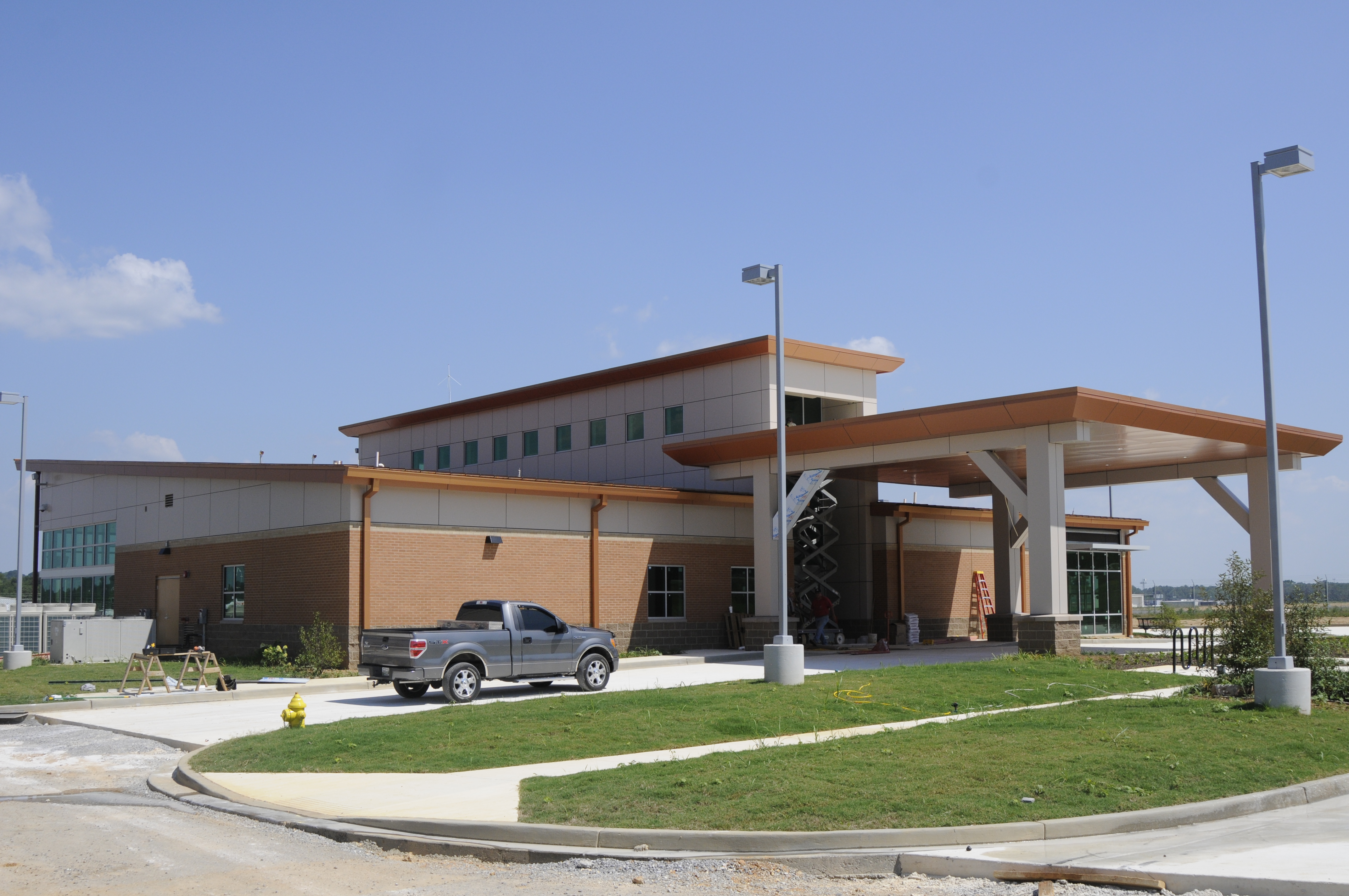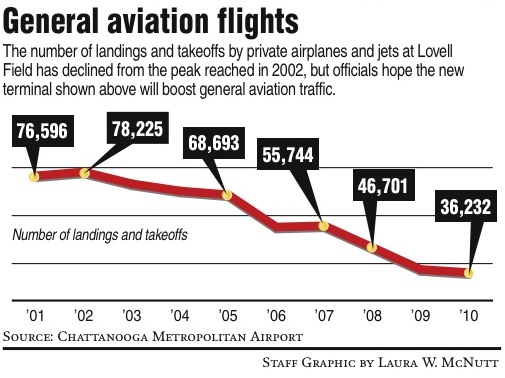Officials say new Chattanooga airport terminal keeps general aviation users in mind
Reaching for the skies
Sunday, July 10, 2011
When Chattanooga airport officials mulled the building of a new general aviation terminal, they traveled to more than a half dozen facilities in the Southeast to find out what worked and why.
"We asked pilots and people who worked there what's important to the customer," said Mike Landguth, Chattanooga Metropolitan Airport's chief executive.
The result is going up on Lovell Field's west side where a $5 million terminal, hangar and fuel farm - part of one of the largest investments in new facilities at the airport in decades - is to open in late summer.
General aviation generally involves activity other than scheduled commercial airline service and regular cargo flights. It ranges from flying for business and personal reasons to the delivery of emergency medical services and pilot training.
Airport officials said the new terminal, and fixed base operator Wilson Air Center, will provide competition to existing FBO Tac Air and its facilities on the opposite side of the runway and better help the city contend for businesses.
Competition "makes everybody better," said Landguth, citing the airlines that vie for passengers at the commercial terminal at the airport.
But Tac Air and others question the need for the new general aviation terminal and FBO, calling them a waste of money.
The Tennessee Center for Policy Research, which bills itself as a "free market think tank," last month listed the airport project on its 2011 Pork Report, noting the city-owned airport is using a grant from the state to pay for 90 percent of the project cost. The airport is picking up the remainder.
"The [Airport Authority] plans to use funding from the Tennessee Department of Transportation to compete against a private company," the advocacy group said in its annual report.
$10 million project
The terminal is the first phase of $10 million in planned new general aviation facilities at the airport. The second phase includes more hangar space.
While one hangar is going up next to the 9,000-square-foot terminal, Landguth said there's space for 60,000 square feet of added hangars when demand drives construction later.
Landguth said the new terminal was laid out to enhance customer service, from the covered entrance to a variety of rooms and amenities inside aimed at appealing to travelers and pilots.
"That's our focus from day one," he said.
Chattanooga businessman Tom Snow, chief executive of T.J. Snow Co. Inc., said his company utilizes the airport frequently to deliver parts to clients and saving it time by not having to use the highways.
"A lot of our customers are not near any major airline hub," said Snow, recently named to the Airport Authority board.
He said the new terminal will be "equivalent to the best I've seen anywhere."
Landguth said the brown facade and glassy look of the new terminal and hangar will blend in with other buildings nearby and create a campus-like atmosphere on the west side, which for many years was undeveloped.
A new road was built to the west side last decade and the U.S. Forest Service constructed a firefighting tanker base at the site. Later, the airport raised a new fire station, and now comes the terminal and hangars that will fill up the campus, Landguth said.
In addition to spurring competition, airport officials said Volkswagen and other businesses in the region will drive usage of the new facilities.
A Federal Aviation Administration-accepted airport master plan expects general aviation activity, which doesn't include commercial flights, to increase from 55,000 operations (either a takeoff or landing) in 2007 to more than 66,000 by 2027 at Lovell Field.
The master plan said the business aircraft market is expected "to grow significantly, as corporate jets replace turboprops and the new lower-cost corporate jets multiply."
However, the recession has pushed general aviation in the opposite direction both locally and nationwide.
The Aircraft Owners & Pilots Association reported that general aviation flight activity has fallen off by more than 10 percent nationwide since 2007. For example, the number of general aviation operations handled by airport towers in 2010 was 28.5 million, up 3 percent over 2009. But that was down from more than 32 million in 2007, according to AOPA.
Chris Dancy of AOPA said general aviation, especially personal use, is closely tied to the economic cycle.
"What people use to fly for themselves is disposable income," he said.
Dancy said AOPA began this year optimistically in terms of general aviation growth, but officials have seen a softening in the economy. Still, AOPA officials are upbeat long-term.
"Looking a few years out, we do see our sector of the economy improving as well," adding that general aviation tends to be a lagging indicator.
In Chattanooga, general aviation activity, including military, was at 36,232 operations in 2010, or down about 3.5 percent from 2009, according to the airport.
However, the 2010 number was about 35 percent below the 2007 level in Chattanooga, before the recession, and less than half the volume at the airport at its peak in 2002.
Proponents of the new terminal said it will bolster business recruitment in the city and could help reverse the downturn in business and individual airplane use.
Dave Ivey, Wilson Air Center's vice president, termed the new terminal "one of the most modern and well-planned corporate flight centers in the country."
"An FBO is the front door - the first and last impression - to business leaders seeking to expand to a region," he said.
Ivey said the city's new facility helps the city compete effectively with other major metro areas such as Atlanta and Nashville.
He said Memphis-based Wilson Air expects to employ a dozen local residents and expand to 20 workers in the first year.
"We've been watching this market for some time, and we knew the timing was right when Volkswagen, Amazon.com, Wacker and other companies started investing," Ivey said.
Airport spokeswoman Christina Siebold said while companies such as VW won't generate lots more traffic, firms that work with and supply the giant automaker will do so.
"It's the spin-off effect of economic growth," she said.
Nearby airports
Meanwhile, officials at other, smaller airports in the Chattanooga area said their facilities don't really compete with Lovell Field.
Chris Swain, the Collegedale airport's operations director, said the two facilities serve different clientele.
"We're more sport aviation ... very little corporate," he said. "We have a different type of business than they have. They're more for airlines, the military and corporations."
David Harmon, airport manager for Cleveland, Tenn.'s Hardwick Field, said Lovell Field has a different identity than its facility.
"We deal strictly with small aircraft," he said.
Cleveland is building a new airport that's slated to open next year, and Harmon expects its general aviation business to pick up.
Swain said general aviation is up a little in Collegedale after falling during the recession.
"It has come up slightly and stabilized," he said.
But Harmon said general aviation has been hurt by higher fuel prices.
"That's impacting it more than anything else," he said.
Contact Mike Pare at mpare@timesfreepress.com or 423-757-6318.


